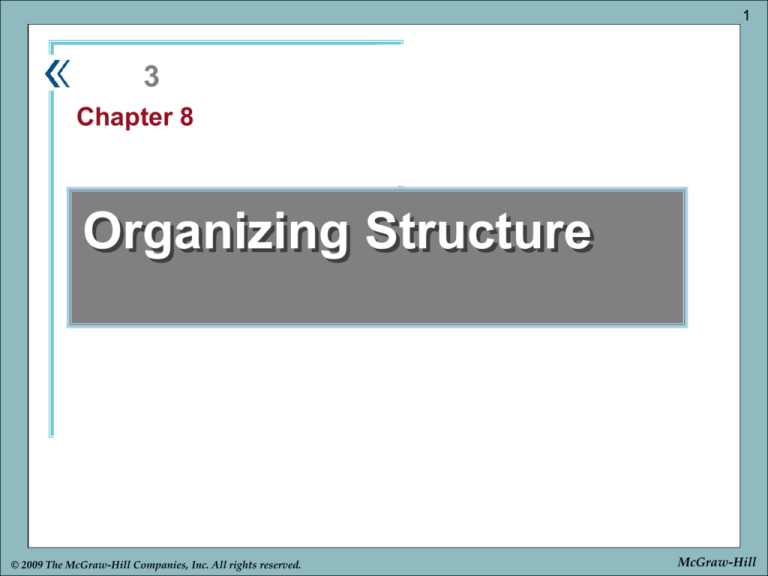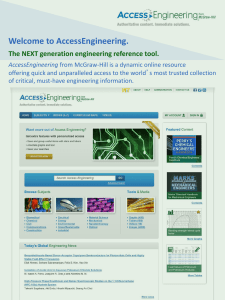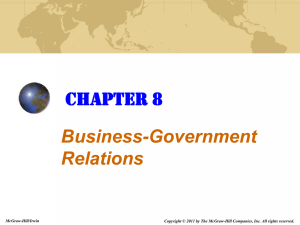
1
part 3
Chapter 8
Chapter
Organizing Structure
© 2009 The McGraw-Hill Companies, Inc. All rights reserved.
McGraw-Hill
2
Learning Objectives
1. Explain the purpose of an organization chart.
2. Describe factors and changes that affect an
organizations structure.
3. Define a contingency approach.
4. Identify the different types of departmentalization.
5. Describe the different types of organizational
structure, including a virtual organization.
6. Discuss the types and effective use of
committees.
McGraw-Hill
© 2009 The McGraw-Hill Companies, Inc. All rights reserved.
3
Organizing Structure
• Reflects how groups compete
• Helps foster good performance
Organizing Growth Stages
• 3 stages – Family, Entrepreneurial, and
Professional Management
• Structure must allows adaptation to change
Organizing Charts
• Series of boxes
• Identifies relationships
McGraw-Hill
© 2009 The McGraw-Hill Companies, Inc. All rights reserved.
4
Factors Affecting Organization
• Important factors – strategy, size, environment,
and technology
Strategy
• Appropriate structure will not guarantee
success
• Structure can help or hinder implementation
• Alfred D. Chandler – structure follows strategy
• Not the only variable to impact structure
• Matching strategy to structure is complex
McGraw-Hill
© 2009 The McGraw-Hill Companies, Inc. All rights reserved.
5
Factors Affecting Organization
Size
• Sales volume
• Small versus large organizations
• Change occurs naturally as an organization
grows in size
Environment
• Tom Burns and G. M. Stalker
• Mechanistic versus Organic systems
• Paul Lawrence and Jay Lorsch
McGraw-Hill
© 2009 The McGraw-Hill Companies, Inc. All rights reserved.
6
Factors Affecting Organization
Organization and Technology
• Joan Woodward
– Three modes of production
– Some findings
• Edward Harvey
– Findings similar to Woodward’s
• General conclusion
– Clear relationship
McGraw-Hill
© 2009 The McGraw-Hill Companies, Inc. All rights reserved.
7
Changes Affecting
Organization Structure
Outsourcing
•
•
•
•
•
McGraw-Hill
Used by large and small companies
Numerous potential benefits
Potential drawbacks
Not a cure-all
Can work well in right situations
© 2009 The McGraw-Hill Companies, Inc. All rights reserved.
8
A Contingency Approach
•
•
•
•
McGraw-Hill
Several factors affect
No one best way to organize
Process of assessing
Analyze and appraise
© 2009 The McGraw-Hill Companies, Inc. All rights reserved.
9
Departmentalization
• Grouping jobs into related work units
Work Functions
• Functional departmentalization
– Primary advantage
– Negative effects
– Conflict
McGraw-Hill
© 2009 The McGraw-Hill Companies, Inc. All rights reserved.
10
Departmentalization
• Product
– Employees identify with product
– Opportunities
– Problems
• Geographic
– Use of local employees
– Creates customer goodwill
– Lead to high service level
McGraw-Hill
© 2009 The McGraw-Hill Companies, Inc. All rights reserved.
11
Departmentalization
• Customer
– Common example
– Advantages and disadvantages
• Other Types – several others
– Simple numbers
– Process or equipment
– Time or shift
• Hybrid Departmentalization
– Departmentalize on one basis then another as the
organization grows
McGraw-Hill
© 2009 The McGraw-Hill Companies, Inc. All rights reserved.
12
Types of Organizational Structures
• Several basic structures – line, line and staff,
and matrix
• New structures horizontal and virtual
Line Structure
•
•
•
•
•
McGraw-Hill
Authority moves top to bottom
Simplest organization structure
Advantage
Disadvantage
Exists in small organizations
© 2009 The McGraw-Hill Companies, Inc. All rights reserved.
13
Types of Organizational Structures
Line and Staff Structures
• Staff functions
• Line functions
Line and Staff Conflicts
• Staff specialists versus
Line managers
McGraw-Hill
© 2009 The McGraw-Hill Companies, Inc. All rights reserved.
14
Types of Organizational Structures
Matrix Structure
•
•
•
•
Project teams
Temporary life
Advantages
Serious problem
– violates unity of command
McGraw-Hill
© 2009 The McGraw-Hill Companies, Inc. All rights reserved.
15
Types of Organizational Structures
Horizontal Structure
• Pure form creates two groups
• Characteristics
• Advantages
The Virtual Organization
• 3 common types
• Network of collaborators
• Technology plays a central role
McGraw-Hill
© 2009 The McGraw-Hill Companies, Inc. All rights reserved.
16
Trends in Organization Structure
• Flat structure versus Tall structure
– No clear conclusion
• Japanese have fewer managers and flatter
structures
• Peters and Waterman – In Search of
Excellence
– Simple form and lean staff
• Today’s trend
McGraw-Hill
© 2009 The McGraw-Hill Companies, Inc. All rights reserved.
17
Committees
• Permanent or temporary
Using Committees Effectively
• First step – function, scope, authority
• Careful thought – selection of members and
chair
Boards of Directors
• Inside and Outside boards
• More active
• Today’s trend
McGraw-Hill
© 2009 The McGraw-Hill Companies, Inc. All rights reserved.






